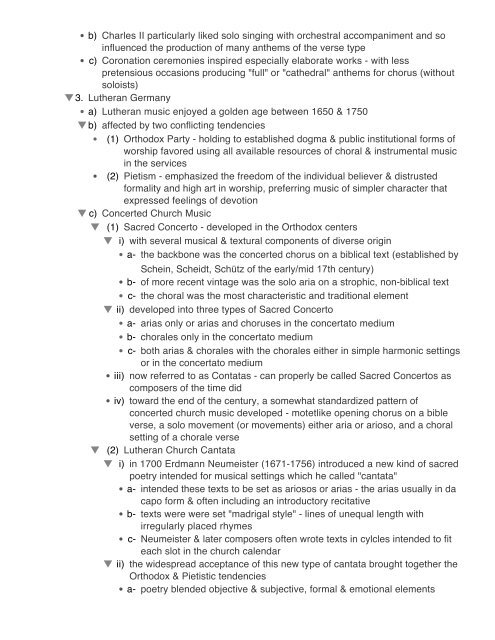An Outline of The History of Western Music Grout ... - The Reel Score
An Outline of The History of Western Music Grout ... - The Reel Score
An Outline of The History of Western Music Grout ... - The Reel Score
You also want an ePaper? Increase the reach of your titles
YUMPU automatically turns print PDFs into web optimized ePapers that Google loves.
) Charles II particularly liked solo singing with orchestral accompaniment and so<br />
influenced the production <strong>of</strong> many anthems <strong>of</strong> the verse type<br />
c) Coronation ceremonies inspired especially elaborate works - with less<br />
pretensious occasions producing "full" or "cathedral" anthems for chorus (without<br />
soloists)<br />
3. Lutheran Germany<br />
a) Lutheran music enjoyed a golden age between 1650 & 1750<br />
b) affected by two conflicting tendencies<br />
(1) Orthodox Party - holding to established dogma & public institutional forms <strong>of</strong><br />
worship favored using all available resources <strong>of</strong> choral & instrumental music<br />
in the services<br />
(2) Pietism - emphasized the freedom <strong>of</strong> the individual believer & distrusted<br />
formality and high art in worship, preferring music <strong>of</strong> simpler character that<br />
expressed feelings <strong>of</strong> devotion<br />
c) Concerted Church <strong>Music</strong><br />
(1) Sacred Concerto - developed in the Orthodox centers<br />
i) with several musical & textural components <strong>of</strong> diverse origin<br />
a- the backbone was the concerted chorus on a biblical text (established by<br />
Schein, Scheidt, Schütz <strong>of</strong> the early/mid 17th century)<br />
b- <strong>of</strong> more recent vintage was the solo aria on a strophic, non-biblical text<br />
c- the choral was the most characteristic and traditional element<br />
ii) developed into three types <strong>of</strong> Sacred Concerto<br />
a- arias only or arias and choruses in the concertato medium<br />
b- chorales only in the concertato medium<br />
c- both arias & chorales with the chorales either in simple harmonic settings<br />
or in the concertato medium<br />
iii) now referred to as Contatas - can properly be called Sacred Concertos as<br />
composers <strong>of</strong> the time did<br />
iv) toward the end <strong>of</strong> the century, a somewhat standardized pattern <strong>of</strong><br />
concerted church music developed - motetlike opening chorus on a bible<br />
verse, a solo movement (or movements) either aria or arioso, and a choral<br />
setting <strong>of</strong> a chorale verse<br />
(2) Lutheran Church Cantata<br />
i) in 1700 Erdmann Neumeister (1671-1756) introduced a new kind <strong>of</strong> sacred<br />
poetry intended for musical settings which he called "cantata"<br />
a- intended these texts to be set as ariosos or arias - the arias usually in da<br />
capo form & <strong>of</strong>ten including an introductory recitative<br />
b- texts were were set "madrigal style" - lines <strong>of</strong> unequal length with<br />
irregularly placed rhymes<br />
c- Neumeister & later composers <strong>of</strong>ten wrote texts in cylcles intended to fit<br />
each slot in the church calendar<br />
ii) the widespread acceptance <strong>of</strong> this new type <strong>of</strong> cantata brought together the<br />
Orthodox & Pietistic tendencies<br />
a- poetry blended objective & subjective, formal & emotional elements<br />
b- musical scheme brought together all the great traditions <strong>of</strong> the past<br />
(chorale, solo song, concertated medium





